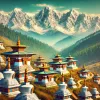Hey everyone, Mark here! As a seasoned backpacker with a passion for exploring Asia, I recently embarked on an incredible journey to Hulunbuir, the largest grassland in China. This vast, breathtaking landscape is unlike anything I've ever experienced, and I'm excited to share my adventures with you.
Hulunbuir: A Vast and Ancient Grassland
Hulunbuir Grassland, located west of the Greater Khingan Range, gets its name from Hulun Lake and Buir Lake. Covering nearly 100,000 square kilometers – an area approaching the combined size of Shandong and Jiangsu provinces – it's a truly immense expanse of land, sparsely populated by around 2.7 million people. This vastness has historically provided sustenance for nomadic tribes. For thousands of years, starting from the Xiongnu period, nomadic peoples such as the Xiongnu, Xianbei, Khitan, Jurchen, and Mongols have roamed these plains, shaping the land and its culture. I found the history absolutely captivating!
The Changing Face of Hulunbuir: A Story of Environmental Challenges
In the 1970s, the grassland boasted grass over two feet high, teeming with wildlife – cattle, wolves, rabbits, and more. However, global warming, increased drought, more frequent strong winds, unsustainable land use, and human activity have taken a toll. Grassland degradation, desertification, and soil salinization are now pressing concerns. This has led to an increase in rodent populations, severely impacting the ecosystem. I witnessed firsthand how the once-lush pastures are now showing signs of deterioration, with stretches of sand replacing vibrant green. This transformation has sadly turned parts of Inner Mongolia into a source of northern sandstorms.
Exploring the Public Grasslands: A Glimpse into Nomadic Life
During my trip, the grass wasn't at its peak (that happens in July and August). My guide and I focused our exploration on the public grasslands to avoid trespassing on private ranches, easily identifiable by the fences (called cao kulun in Mongolian). The public grasslands, fueled by rivers like the Moriger River, provide vital water sources for both people and livestock, underscoring the community-based use of resources. A simple, yet powerful gesture I learned was the offering of a sip of spirits: a gesture of respect to Heaven and Earth and to one’s ancestors.
The Legacy of the Golden Horde: Tracing the Roots of the Mongol Empire
My journey took me deeper into history. The mention of the Golden Horde (Kipchak Khanate) immediately catapulted me into the rich history of the Mongol Empire. This powerful khanate, one of the four successor states of the Mongol Empire, controlled a vast region spanning the Caspian and Aral Seas, parts of Russia, and into Eastern and Central Europe from the 13th to 15th centuries. It was ruled by Batu Khan, grandson of Genghis Khan.
The Mongol Empire's sprawling influence extended far beyond Hulunbuir. Genghis Khan's conquests laid the foundation for a vast empire, but its fragmentation after his death gave rise to multiple successor states. I was stunned to learn the Mongol Empire, in its various forms, controlled a staggering 21 states over 400 years! The story goes on from Batu to his brothers Orda and Sheiban, who founded the White and Blue Hordes, respectively, further expanding the Mongol Empire's reach. The sheer scale of this empire was mind-blowing.
| Khanate | Location | Significance |
|---|---|---|
| Golden Horde (Kipchak) | Caspian and Aral Seas, parts of Russia, Eastern & Central Europe | One of the four major successor states of the Mongol Empire; controlled a vast territory for centuries |
| White Horde | Northwest Asia | Ruled by Orda Khan, Batu Khan's brother |
| Blue Horde | Southern Ural Region | Ruled by Sheiban Khan, Batu Khan's brother |
The Enduring Impact of the Mongol Empire on Russia
The Mongol Empire's impact on Russia is particularly striking. Mongol rule lasted for approximately 250 years, profoundly shaping Russian culture, politics, and society. The saying, "Scratch a Russian, and you will find a Tatar," highlights the lasting influence of the Mongol-Tatar people. The architectural marvel of the Kremlin, whose name derives from the Mongol word for fortress (kremlin), stands as a testament to this legacy. Even the word "Ukraine" is of Mongol origin, meaning "borderland." Even many Russian physical features and the traditional food of Russia are said to be influenced by the Mongolians.
Zhalong Nature Reserve: A Sanctuary for the Majestic Red-crowned Crane
My journey concluded in Qiqihar, home to the Zhalong National Nature Reserve – a haven for the endangered red-crowned crane ( Grus japonensis). This stunning bird, symbolizing longevity and good fortune in Chinese culture, is a sight to behold. I learned that the red-crowned crane migrates between its breeding grounds in Northeast China and its wintering grounds in the lower Yangtze River area and Japan. In Hokkaido, Japan, however, a population of red-crowned cranes remain year-round, likely because of organized feeding programs, making them a local resident bird. I was able to witness them in their natural habitat – truly an unforgettable experience.
Qiqihar and the Daur People: Echoes of the Khitan
Qiqihar, meaning "natural pasture" in Daur, connects me to the Daur people, considered by many scholars to be descendants of the Khitan. The Khitan, who established the Liao Dynasty (907-1125 CE), left an indelible mark on Chinese history. Their influence was so significant that ten countries still refer to China as "Khitan." Although no longer recognized as a separate ethnicity in China's 56 official ethnic groups, the legacy of the Khitan lives on through the Daur people and other groups who adopted Khitan customs, cultures, and languages over the centuries.
Harbin Grand Theatre: A Symphony of Architecture and Sound
My trip concluded in Harbin, a city known for its music scene. The newly constructed Harbin Grand Theatre is a magnificent architectural masterpiece crafted from ash wood. It provides a stunning venue for musical performances and showcases the remarkable skill of Chinese architects. This architectural marvel truly left me breathless, a perfect finale to my unforgettable Asian adventure.







